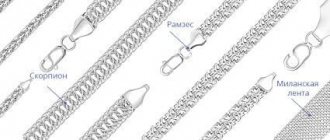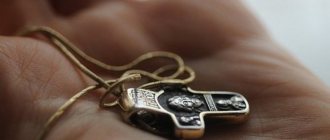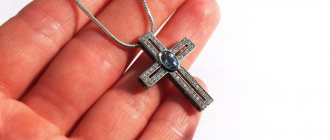Melting of gold and silver products is a standard service of the workshop in Moscow.
First you need to decide why exactly you need remelting? If you want to subsequently order the production of jewelry, then the cost of melting will be included in the cost of production, that is, FREE !
You can find production prices here.
If you just want to melt the jewelry into an ingot, then the price will be calculated based on the contamination of the jewelry and the number of inserts. On average, the cost of melting 20 grams of gold into an ingot is 350 rubles , and melting silver is around 200 rubles .
Important - The truth about melting down!
Some clients believe that after melting down and then ordering jewelry for themselves, they will receive a new product made from the same metal that they gave! It is not true! If the workshop promises you that they will make it from your metal, then they are blatantly lying!
It is possible to make exactly from your metal during melting only when the work is done entirely by hand from wire. At the same time, there should be enough metal in reserve!
In all other cases, the metal is sent for refining and then new jewelry is cast from the purified material. Yes, exactly new, virgin, purified metal.
And we’ll repeat this again! If you need to melt down gold into a ring, or even melt down an old ring into a new ring, then 99% of the time you will have a piece made from brand new, purified metal.
How much does it cost to melt down a gold item?
If your chain or bracelet is broken, it will be more profitable and much faster to simply repair the product, because the jewelry will weigh little by gram, and jewelry makers charge for each gram that is melted down. The price of melting gold in this case can significantly exceed the finished product, which can be bought at the same jewelry store. It is profitable to melt several products whose weight will exceed 10 grams.
Imagine that you were given a small golden sculpture; it is better to melt it down and make several rings out of it, than for it to stand in your closet and gather dust. And looking at the beautiful products that you will wear, pleasant memories of the person who gave you such a generous gift will come to mind.
On average, in many jewelry workshops it costs 500 rubles per gram to melt gold of the lowest standard 375. Craftsmen have to clean low-grade metal from various impurities quite carefully so that the final product turns out beautiful, shiny and not cloudy. Keep this in mind if you decide to recycle low grade material.
Many buyers bring cheap precious metals from China or Turkey for processing. There are few craftsmen who will undertake to melt such low-quality and cheap material; you will have to carefully look for someone who will begin to fulfill your request.
The most popular standard of gold products is 585. How much does it cost to remelt 585 gold? In each workshop it is different, depending on the qualifications of the master, on average from 1000 to 1500 rubles. Agree, pleasure is not cheap.
The melted material evaporates by 10% during processing; no one will return this difference to you, since the error, although small, will be there in any case. During operation, the material may splash, and before starting, during melting, it flies away.
Orthodox Life
Archpriest Vladimir Rovinsky knows what to do with a pectoral cross that has become unusable.
It must be remembered that a pectoral cross cannot be equated to jewelry. Indeed, during its consecration (which should take place in the altar on the holy throne), the priest, turning to Christ the Savior, prayerfully asks: “You voluntarily, for the sake of our salvation, desired to be nailed on the Tree of the Cross and deigned to sanctify it with Your precious Blood,” and then : “And bless this sign of the Cross, and pour Your intercession help against all the snares of the devil into it, so that for everyone who wears it, it will provide protection and saving salvation from all evil of the soul and body, and for the multiplication in him of Your spiritual and Christian gifts. served the virtues by Thy grace.”
The pectoral cross serves us, on the one hand, as a symbol of our faith, a reminder of Christ’s death on the Cross and the sanctification of the instrument of death itself by His Blood, and on the other hand, it is filled with the grace-filled energy of the Holy Spirit, preserving us from all evil and increasing our virtues and talents. It is customary to take a cross that has become unusable to a church, on the territory of which a special place should be allocated for storing or disposing of consecrated things.
But not every unsuitable consecrated thing needs to be taken to the temple. I remember when I was a new parish priest, I advised parishioners to bring relics unfit for use to church. Oh, what started here! In a short period of time, behind the altar there grew a huge mountain of bottles of holy water, vials of blessed oil, moldy prosphora, images of icons from magazines and newspapers, blessed willow, jars of cloudy Epiphany water, some ribbons, handkerchiefs, and more occult literature and much more. Parishioners even from other churches in the city, having learned about my blessing, joyfully came to us to get rid of everything that their faith-filled soul could not afford to throw in the trash. I soon realized that in order to properly and regularly dispose of all this, I would have to support another church worker.
After that, for six months, I ended every Sunday sermon with a request not to bring to church everything that could be burned at home, but to bury the ashes in the ground in a clean place. As for a broken cross, if it is made of precious metal, it can be sent to a workshop to be melted down to make a new one.
How long will the gold melting process take?
What determines the longevity of the process:
- The first thing that is important when melting down a gold product is the hallmark that was on the product. The higher the standard of the jewelry, the better and faster the jeweler will make you a new piece from one or several old ones. Since high purity jewelry contains absolutely no impurities, there is no need to clean them, which means the melting process is significantly accelerated. Keep this in mind when taking your jewelry to a jewelry store.
- Remember that the process may take longer if, instead of a regular ring, you ordered a ring with stones or with complex weaving. The master will spend much more time making a complex product, which in the end will delight you with its beauty and pleasant golden shine.
- Putting a test on a new manufactured product also takes some time from the master.
On average, it takes an experienced jeweler to melt down and make a new piece from one to two months, again depending on all the factors described above.
When paying for and accepting a new product, look at the sample with a magnifying glass, inspect the product and be sure to take a receipt that says what product your new jewelry was made from.
Gold melting prices may vary depending on the city where you live and how experienced and qualified the craftsman is. After all, as we all know, craftsmen who have extensive experience charge good money for their work. But in this case you will get an excellent product.
ALL ABOUT THE NATURAL CROSS
Father Ilya Palibin, the rector of the church in honor of the Holy Blessed Prince Alexander Nevsky, answers questions from parishioners
— What is a pectoral cross? — The body cross is a visible evidence of belonging to the Orthodox Church, confession of the Christian faith, a means of grace-filled protection.
The cross is the greatest Christian shrine, a visible evidence of our redemption. In the service for the Feast of the Exaltation, the Church glorifies the tree of the Cross of the Lord with many praises: the Cross is the guardian of the entire universe, the beauty of the Church, the power of kings, the affirmation of the faithful, the glory of angels and the plague of demons.
A pectoral cross is given to a baptized person who becomes a Christian and is constantly worn in the most important place (near the heart) as an image of the Cross of the Lord, an external sign of an Orthodox Christian. This is also done as a reminder that the Cross of Christ is a weapon against fallen spirits, having the power to heal and give life. That is why the Cross of the Lord is called Life-Giving!
He is evidence that a person is a Christian (a follower of Christ and a member of His Church). This is why it is a sin for those who wear a cross for fashion without being a member of the Church. Consciously wearing a cross on the body is a wordless prayer, allowing this cross to demonstrate the true power of the Archetype - the Cross of Christ, which always protects the wearer, even if he does not ask for help or does not have the opportunity to cross himself.
While performing the Sacrament of Baptism, the priest puts a cross on the baby, which from that moment becomes the inseparable companion of the new member of the Church. It is not customary to remove a cross when bathing or changing clothes (in the old days there were even wooden crosses in the baths, which were worn in the steam room instead of their own).
There are canonical forms of crosses - four-, six-, eight-pointed. In Rus', eight-pointed crosses are more common, on the back of which, according to tradition, the inscription “Save and Preserve” is written. Saint Demetrius of Rostov wrote back in the 18th century: “We reverence the Cross of Christ not by the number of trees, not by the number of ends, but by Christ himself, whose Most Holy Blood was stained with Him. Displaying miraculous power, any Cross does not act by itself, but by the power of Christ crucified on it and by invoking His Most Holy Name.”
There are no rules about the material for crosses. Obviously, precious metals are also acceptable here, because for a Christian nothing can be more valuable than a cross—hence the desire to decorate it. But, of course, simple wooden or metal crosses are closer in spirit to the Cross of the Lord. There is also no fundamental difference between a chain and a braid: it is important that the cross is held firmly. The cross should not be removed, incl. during washing and sports activities. Lay people wear a cross (on the body) under their clothes, without deliberately showing it off.
In the first centuries of Russia’s adoption of Christianity, crosses were worn not on the body, but on top of clothing “as clear indicators of Christian baptism.” Later, only bishops had the right to wear a cross over their clothes until the 18th century, and even later - priests. The priestly pectoral cross is called a pectoral cross (“persi” in Church Slavonic means “chest”). Along with the pectoral, priests also wear a pectoral cross.
Russian people swore allegiance on crosses, and by exchanging pectoral crosses, they became cross brothers. When building churches, houses, and bridges, a cross was laid in the foundation. There was a custom to cast many crosses from a broken church bell, which were especially revered. Taking off one's cross or not wearing it has always been understood as apostasy. Over the 2000-year history of Christianity, many people have suffered for their faith, for refusing to renounce Christ and take off their pectoral cross. This feat has been repeated in our time.
— What does the loss of a pectoral cross mean? - Nothing except some inattention and negligence of the loser.
It should be said that there are many superstitions associated with the pectoral cross: if you lose the cross, disaster will happen; a cross lost by someone cannot be picked up; a cross cannot be given as a gift, worn on a chain, and the like. All of them have no basis: you can buy a new cross, wear one that was given or found, and consecrate it in the temple. Those crosses that are sold in the church are consecrated.
— What to do with a found cross? — Once you find a pectoral cross, you can keep it at home, you can give it to a church or to someone who needs it. Superstitions regarding the fact that if we find somewhere a cross lost by someone, then we cannot take it, since by doing so we take on other people’s sorrows and temptations, are baseless, since the Lord is a person, and not a soulless mechanism. If you want to wear a found cross, it must be consecrated.
— Is it possible to give a pectoral cross? - Of course, it’s possible.
— Is it possible, instead of a pectoral cross, to wear a pendant with the image of the Virgin Mary and an amulet consecrated on holy relics? — An Orthodox Christian, first of all, should always wear a cross and never take it off. The cross is the most important symbol with which we testify to the world and remind ourselves of the most important thing, the sacrifice of Christ for us and our salvation. Pendants and amulet are secondary, but if you want to wear them, you can put them on one string with a cross.
— Is it allowed to melt a gold cross into another piece of jewelry? - Only on a different cross. Otherwise there will be blasphemy, that is, inappropriate treatment of a shrine.
— Can I wear the cross that my mother wore? — You can wear another person’s pectoral cross, it’s not dangerous. There is a misconception that the cross transfers the sins of another, but THIS IS NOT SO!!! It would be very easy and simple to get rid of your sins in this way - throw the cross into the bushes and that’s it; or give it to someone and that’s the end of it! I will say more that if you find a cross or an icon on the street, you MUST PICK IT UP! These are shrines, it is better to pick them up and bring them to the temple than to walk on them!
— Is it possible to remove the cross when playing sports, for example, wrestling or boxing? — It is very undesirable to remove the cross, even in sports. For convenience, you can wear a small wooden cross on a short string.
— Is it a sin to wear a cross on one chain and a pendant with a dragon on another chain at the same time? — An Orthodox Christian cannot wear a pendant with a dragon, even on his back. The dragon is the image of the devil.
— Is it possible to consecrate a cross at home - with holy water or do you need to take it to church? — The priest must read the prayers for the consecration of the cross. And where he reads them - in the temple, or in the house - by and large does not matter.









